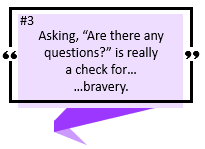19 Mar Words of Wisdom #3: Check Student Understanding
“Are there any questions?” is not a reliable method to check student understanding. Substituting the words “What are you wondering? Or “What have I not made clear?” creates the opportunity for students to express safely what they do not yet understand.
CHECKING FOR BRAVERY, NOT STUDENT UNDERSTANDING
“Are there any questions?” Here is a ubiquitous interrogative phrase teachers utter after just about any explanation. Teachers generally intend it to check student understanding. But consider it from a student’s point of view – especially if you are an adolescent student. Here is an invitation to appear ignorant before your classmates. Here is a chance to show the world that whatever “it” is, you don’t “get” it. The teacher wants you to admit you don’t understand something? Talk about painting a target for teasing on your own psyche! No thanks! You’ll choose to keep your mouth shut and your psyche safe. And the teacher will never know if your silence means understanding or emotional self-protection.
I confess I checked students’ bravery many times before I finally realized that this question did little to check student understanding. Case in point…

True Story – The Proxy Questioner
I noticed one year in one class, whenever I asked Are there any questions?, one high- achieving student always had at least one question. He was almost always the only one to respond to this question. Yes, it was almost always a question about something I was sure he already knew. One day after school I questioned him about his repeated queries. He admitted that most of the time he was really asking questions for two bilingual who students sat near him. They often had questions but were afraid to ask. He continued, “They say that since I’m smart, it doesn’t matter if I ask questions. But they’re afraid if they ask something, others will laugh and think they’re dumb.” And with that, I “got it,” – and I began looking for better way to check student understanding and draw out what was in students’ heads.
MORE EFFECTIVE QUESTIONS TO CHECK STUDENT UNDERSTANDING
Like all teachers, I had been interpreting the absence of student response to this query as proof of my instructional excellence. WHOA! This question was not achieving my goal. But substituting these words AND allowing three to five seconds of think time worked wonders (pun intended):
“So – what are you wondering?”
Students (and adults) find it much more emotionally safe to admit to wondering something rather than having a question. “Having a question” after an explanation connotes a lack of understanding. Students see this as not a good thing. But “wondering” connotes curiosity and intelligence– not a bad thing.
Yet another phrase that can work well to more accurately check student understanding is one that puts the onus back on the teacher:
“So – what have I not made clear?”
With this phrasing, the “error” is not on the student’s part for not understanding. It is on the teacher’s part for not providing clear explanation.
OPTIMIZING WAIT TIME TO CHECK STUDENT UNDERSTANDING
Now about that “wait time” thing. Did you know students typically get less than a second to think before they are expected to reply? Really! Studies show that extending that to a minimum of three to five seconds results in more students responding. And they respond at higher levels of thinking (Gage & Berliner, 1992). If you really want to check student understanding and not just student response speed, give them time to think.
True Story – The Shoe on the Other Foot
We were discussing wait time in a workshop session, and a fifth-grade science teacher shared her own traumatic awakening experience. She shared: “After 20 years of teaching, I chose to participate as a student in a rather advanced summer college course for a special certification. What a wake-up call! Now I am not dumb, but in class I needed more time to process what the prof was putting out there. He’d give a lecture and then ask, ‘Are there any questions?’ Before I could pull my thoughts together even to begin to formulate a question, he’d say, ‘Good’ and move on. My brain was shouting, ‘Wait! Wait! Go back!’ – but I kept my mouth closed for fear of looking stupid in front of others in the class. And then it hit me – the frustration and fear I was experiencing was no doubt identical to that of some of my own students.”
IN SUMMARY…
QUESTION: How do we get students to examine their current understanding – and lack thereof – and be brave enough to ‘fess up and to verbalize what is in their heads?
ANSWER: We use words that connote curiosity and intelligence – and we give them time to think.
I encourage you to try using the “…wondering” question instead of the “are there any…” one. See if you get more – and more accurate – student responses, as well as more student comfort in giving those responses. And if you’re feeling brave enough to paint the target on yourself, ask what you have not made clear. I promise, students will give you feedback on that one.

Asking “What are you wondering? or “What have I not made clear?” will better check student understanding. Students are eager to display curiosity, but hesitant to reveal a lack of understanding
Until next week – may you experience success in all your academic endeavors!
Alene
Gage, N.L. & Berliner, D.C. (1992). Educational Psychology (5th ed.). Boston: Houghton Mifflin.


